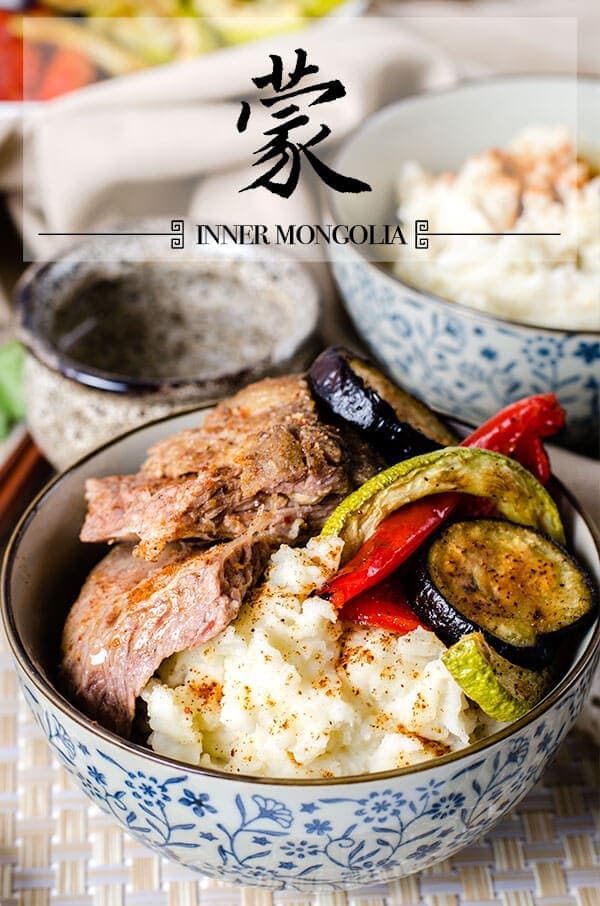
The lamb is nicely charred and crispy on the surface, its meat tender and moist. The simple cumin and chili seasoning brings out the aroma of the lamb without tasting overwhelming. Your kitchen will get messy but smell heavenly!
Mongolian Food – Lost in Translation
You might have heard of or tried a dish called Mongolian beef, but this Mongolian lamb or any authentic Mongolian dish is nothing like it.
Seasonings of real Mongolian food are very simple and minimal. Salt and pepper are commonly used, sometimes with the combination of cumin powder and chili flakes. When we are talking about Mongolian food in the context of China, we often refer to Inner Mongolia, an ethnically Mongolian province of China that borders the country of Mongolia. Its food and seasonings are also affected by the rest of China.
For the main ingredients of Mongolian food, mutton and lamb will be at the top of the list, way above other meat, such as beef and chicken. Other important ingredients in daily life also include flour and milk, with very limited amounts of vegetables. When it comes to cooking, roast whole lamb, roast lamb leg, and naan bread are the most popular and commonly known items. Compared to mainstream Chinese food, Mongolian style roasting often features bigger cuts and larger chunks of meat.
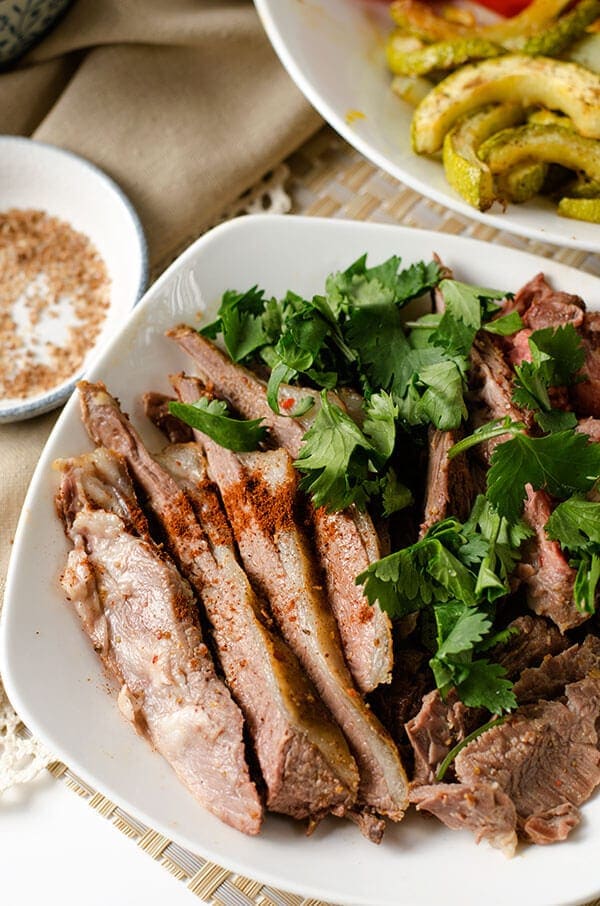
Hunting for the Right Cut
Expats in China are often annoyed that they cannot find the right cut of meat for a decent steak or lamb chop, as Chinese butchers generally cut meat differently from Western butchers. I face the same problem even when cooking Chinese food.
When I was trying to find lamb shanks at local markets, I came home disappointed and empty handed a few times. There was one time I even hunted down a halal butcher next to a small hidden mosque. I found that their lamb cuts were still very huge, with thick and tough meat. Later on, I realized that people here tend to raise the lambs to a bigger size, in order to get more meat.
Don’t get me wrong, you can still find nice lamb chops if you’re in a fancy neighborhood. But I found it’s much easier to get a cut of lamb spare ribs at the average supermarket, as it’s way cheaper.
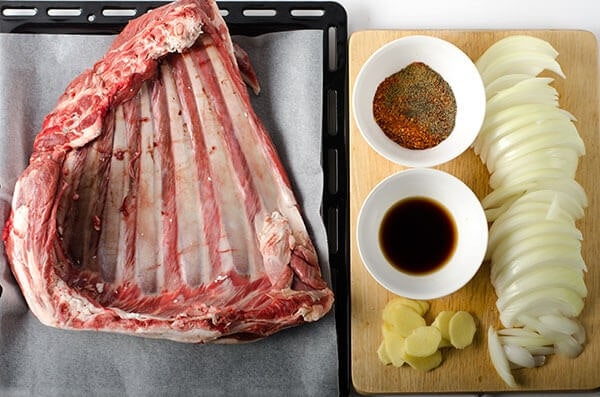
It might be difficult to judge the size of the piece of lamb above, but it weighs 1.5 kilograms (3.3 pounds)! Can you imagine how tough the meat was? Continue to read and you will find out how to tackle this problem!

Lamb meat is wildly popular in China and we simply don’t have enough pastures to raise the sheep. As a result, lamb meat is pricey and sometimes difficult to get (I don’t even want to start on the topic of the rampant fake lamb meat). You can find the most common cuts in a big supermarket (in Beijing), which normally includes lamb leg, spare ribs, and lamb breast (because there is a conspiracy theory that the restaurants get all the good parts first…just kidding. I hope!).
Cooking and Tips
Today, I want to introduce a Mongolian-style dish that uses chili and cumin to season and roast a whole piece of lamb spare ribs.
To specify the cut, the spare ribs I’m using here are a Chinese style cut, which contains both the bone-in breast and most of the rack (in the US terminology). In China, we usually separate the entire backbone and cook it in a stew. The backbone is a popular cut (羊蝎子, yang xie zi) here.
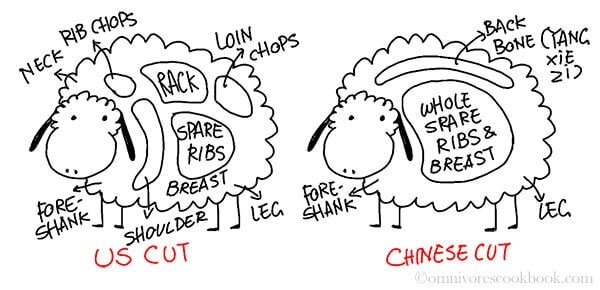
For lamb spare ribs, the most common home cooking method is a stew or braised dish. The whole piece is just too huge and the meat is quite thick and tough. However, I found a great way to roast the whole piece in the oven, and the result was great.
Cooking alert! Making this is quite messy and you should expect your kitchen counter and hands to get very greasy. But believe me, it’s totally worth it!
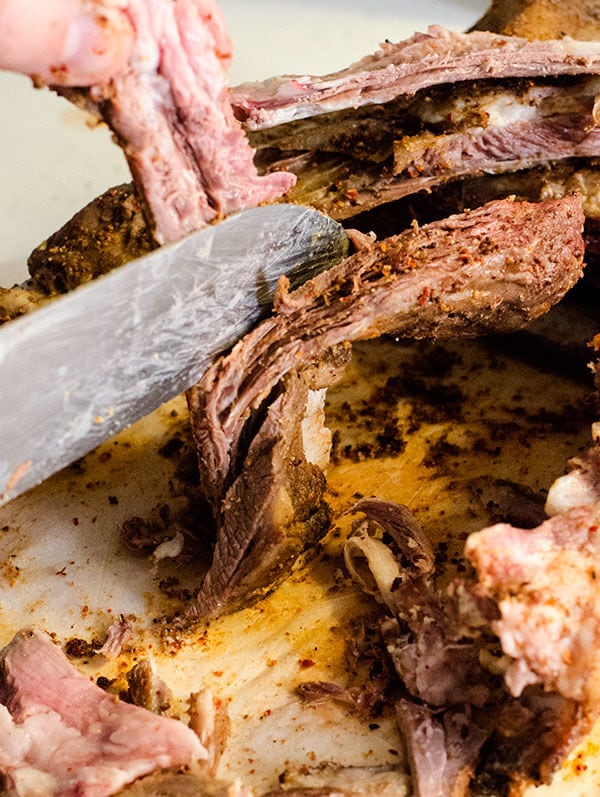
To cook this recipe, I did a lot of research online and learned the tips and tricks from various recipes. Here are a few tips.
- Use the whole piece of spare ribs without splitting it, so the meat won’t dry out in the oven.
- Make sure you marinate the lamb for enough time.
- Transfer the lamb from the fridge and let it return to room temperature before roasting.
- Carefully peel of the plastic wrap off and throw it away! Believe it or not, I almost forgot to do this before putting the lamb in the oven. Oopsy!
- Rub a thick layer of spices onto the lamb for marinating, and again in the middle of roasting.
- Roast the lamb first in aluminum foil at low temperature until tender, and then without the foil at high temperature to get a crispy surface.
- Slice the meat from the bone into smaller pieces before serving (skip this and eat with your hands if you want it the authentic way!).
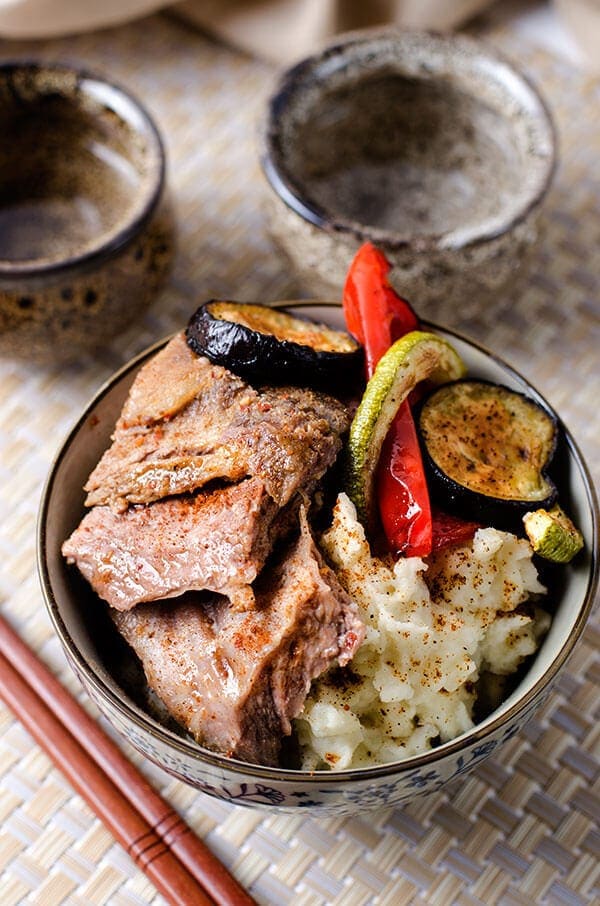
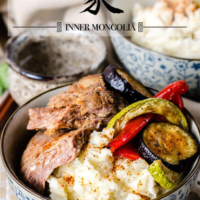
Mongolian Roasted Lamb Spare Ribs
Ingredients
- 1 onion sliced
- 4 tablespoons cumin powder
- 4 tablespoons chili flakes
- 1 tablespoon soy sauce
- 1 tablespoon Shaoxing wine
- 1.5 kilograms 3 pounds lamb spare ribs (contains rack and bone-in breast)
- sea salt
- 10 cloves garlic coarsely sliced
- 2 thumbs ginger sliced
- 1/2 teaspoon black pepper
Instructions
- Combine onion, 2 tablespoons cumin powder and 2 tablespoons chili flakes in a large bowl. Add soy sauce and Shaoxing wine. Mix well until the onion is evenly coated with spices.
- Place lamb on a large working surface, meat side up. Grind a generous amount of sea salt over the top side of the lamb and rub to season.
- Spread plastic wrap on a working surface without cutting it, a bit larger than the size of the lamb breast. Spread half of the onion, garlic and ginger evenly over the plastic wrap and place lamb on top of onion, meat side down.
- Grind sea salt over the bone side of the lamb and pat several times to let salt absorb well. Spread the rest of the onion, ginger, and garlic evenly over the lamb, taking care to not leave any inch of the lamb uncovered.
- Wrap lamb in several layers of plastic wrap, until every inch of the lamb is covered well. Place in a large plastic bag and seal with a clip (or in a large tray sealed with plastic wrap). Marinate in fridge for 24 hours.
- Transfer the lamb from fridge to kitchen counter and let it return to room temperature before roasting, at least for 1 hour.
- Preheat oven to 190 degrees C (370 F).
- Spread aluminum foil over a baking tray, shiny side up (*see footnote). Unwrap lamb and discard the plastic wrap (be careful not to leave any piece of plastic wrap on the lamb). Transfer the lamb, and all the onion, garlic and ginger to the foil. Wrap the lamb in several layers of foil until the lamb is fully covered, shiny side facing inward. Bake at 190 degrees C (370 F) for 50 minutes.
- Transfer lamb to kitchen counter and allow it to cool down a bit until you can handle the foil.
- Increase the oven temperature to 220 degrees C (430 F).
- Mix the remaining 2 tablespoons cumin powder and chili flakes in a small bowl.
- Unwrap foil carefully with tongs. Remove the onion and discard it. Sprinkle half of the cumin and chili mixture evenly over the lamb.
- Carefully flip the lamp and place it on a roasting rack, and spread the remaining cumin and chili mixture on the other side.
- Bake on the middle rack at 220 degrees C (430 F) for 20 minutes, until the lamb is cooked through and the surface is nicely charred.
- Transfer lamb to kitchen counter and allow to cool until you can handle the lamb, about 15 minutes. Split the ribs and slice meat into thin slices.
- Serve warm as a main over rice or mashed potato.
The nutrition facts are calculated based on 1 of the 6 servings generated from this recipe.
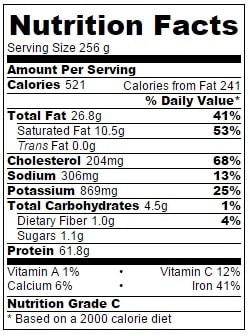













Can’t remember the last time that I cooked lamb. I definitely am so inspired right now to go out and buy some so I can make this roast lamb breast.. it looks like quite an undertaking but I bet the end result is worth it!
Just look at that lamb breast. This looks like the perfect dish for someone that is dealing with winter like me lol. Amazing post.
I’ve never had Mongolian food, but I can safely say I would devour this dish. Looks so good.
Hi Janette, thanks for stopping by and so glad you like this one!
I’m so so happy I found your blog, Maggie! Just love reading about China and the amazing variety of food there!
You just have to tell us about the ‘fake lamb’ (wha …????) Oh, go on, just a little … 😉
The spare ribs sound just amazing … again, you’ve made me feel like I can accomplish some amazing authentic Chinese flavours really easily.
Thanks Helen! There are so many great food here and I tried as much as possible to make my recipes look less daunting. So glad they look easy enough!
Lamb meat is expensive and in short here, so some restaurants use beef or pork (blended with lamb fat) to replace lamb meat. Because of the heavy seasoning and the strong aroma from the lamb fat, people usually can’t tell the difference. And this is the good case actually. Sometimes very bed things can happen too (street vendors are reported to use game meat that is not safe to be eaten). I won’t say too much here to scare you off! lol. Anyhow, I really prefer to cook lamb at home (the raw ones are real). At least I know what I’m cooking with! 😉
Your blog is lovely Maggie – love the sheep cartoon and this recipe looks wonderful – year of the sheep – yum – eat more sheep my favourite meat!
Thanks for stopping by Rachel! Lamb is one of my favorite meat too and the year of sheep definitely gives me a proper reason to cook more with it! Have a great weekend and happy cooking! 🙂
What an incredible treat to read and learn about your roasted lamb recipe, Maggie! Lamb can be very dry and chewy if the meat is from an old lamb or not prepared properly. The next time we will try your way and marinate it overnight, perhaps it will make the meat more tender.
Love your darling info sheep 🙂
You are absolutely right about the lamb. I had some bad experience of cooking with lamb before, which is the reason why I didn’t posted a single lamb recipe on the blog for a year! It’s indeed very intimidating to roast a big piece of lamb, but luckily I found the way to deal with it. I tried the marinating method for a few times, including with smaller leg cut, and it worked out well so far (I won’t say it’s as tender as medium rare lamb rack, but it’s good enough for this cut). Let me know if the method works for you next time!
Thanks for stopping by and have a great weekend! 🙂
I never think of lamb when I think of Chinese cooking!! I’m so glad you shared this, I want to start exploring it!!
If you ever come to China, you’ll find how popular it is here! 2015 is the year of sheep, more lamb recipes are coming soon!
Maggie, I love this recipe and thanks for sharing your way of cooking lamb. Never thought that it was popular in China! Love the cumin and chili seasoning. My mom makes lamb usually around Easter, but it always takes her hours to cook, that’s why I’ve been discourages to even try making it. Will be trying your recipe with a small piece of spare ribs. Pinning!
The idea of fake lamb?- I guess people will do anything for money 🙂
I’ve never tried cooking lamb at home before. I can just imagine how flavorful and tender this is! Your step by step photos are always so pretty and helpful 🙂
Maggie, I learned so much in this post! Thank you. And this recipe is right up my alley – I’ve added it to my ‘try soon’ list!!
The ingredient list calls for ginger and garlic but there’s no mention of garlic or ginger in the instructions? At what point do you use the garlic & ginger?
Hi JJ, thanks for noticing my mistake! I just update the recipe. You should add them with the onions before marinating.
Happy cooking and hope your dish turns out great!
Cooking time doesn’t seem to add up. other recipes have cook times of a couple hours. This says 50min then 20min. For a total of 1hr 10min, but also says the cook time is an hour and a half. Sounds like a wonderful recipe and I will try but I would hate to undercook.
I will also try you recipe for instant pot chicken noodle soup! Sounds sooo good 🙂
When do you use the black pepper
I enjoyed the new flavor of the lamb breast. This was a wonderful discovery to the various ways that lamb meat can be cooked! Thanks.
Made this with rack of lamb and also threw in some Szechuan peppercorn – absolutely epic! Thank you for publishing all of the wonderful recipes!